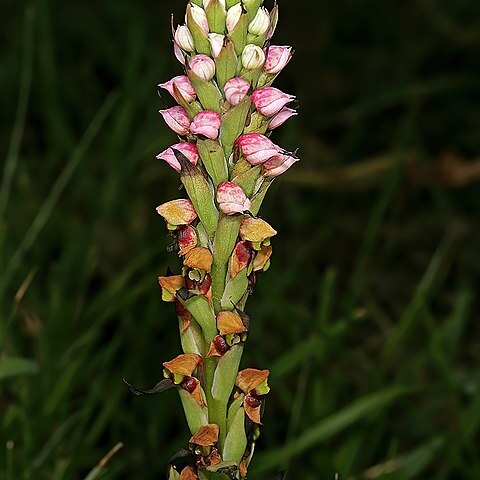Terrestrial herb, moderately robust, geophyte, 0.2-0.7 m high; root tubers present. Leaves of sterile shoot basal, up to 335 x 30 mm; of fertile shoot cauline, grading into floral bracts. Inflorescence a dense, cylindrical raceme; flowers 50-105, imbricate, resupinate, buds pale pink mottled darker pink to maroon, open flower yellow-brown mottled plum-red. Sepals 4.5-6.5 mm long, median sepal deeply galeate, lateral sepals spreading; spur cylindrical, ascending, sharply deflexed, 5-7 mm long, apex swollen. Petals obliquely narrowly oblong. Lip strap-shaped, pendent, 4 mm long, widest at apex. Flowering time Dec.-Mar.
Herb, up to 0.5 m high, with or without separate sterile shoots. Leaves soft, sterile leaves (10-)20-30(-40) mm wide, rarely petiolate, conduplicate, cauline leaves imbricate. Flowers: floral bracts green; spur shorter than median sepal, pendent or sharply curved downwards, reaching below base of dorsal sepal, > 4.5 mm long; lip thin; viscidia 2 on a 3-lobed rostellum; perianth mottled pink; Dec.-Feb.
Fertile shoots (20)30–50(70) cm tall; cauline leaves usually imbricate, mostly sheathing, grading apically into the floral bracts, to 12 cm long, lanceolate to narrowly lanceolate, acute.
Flowers usually facing down; colours variable, pink to scarlet or reddish, often mottled, sepals often turning brown at anthesis, lip and petals green from a purple base.
Terrestrial herb, up to 500 mm tall. Sterile leaves (10-)20-30(-40) mm wide. Spur reaching below base of dorsal sepal, longer than 4.5 mm. Flowers mottled pink.
Dorsal sepal angled downwards, galeate; galea 4.5–6.5 mm long, 3.5–4.5 mm wide and 3–4.5 mm deep, ovate to broadly elliptic, obtusely or bluntly apiculate.
Sterile shoots 4–7 cm tall, (3)5-leaved; leaves semi-erect, conduplicate, rarely petiolate, 15–30(40) cm long, very narrowly elliptic, acute.
Petals 4–5 mm long, obliquely ovate, acute, erect, partially exserted from the galea, deflexed inwards in about the middle.
Spur from the middle of the galea, straight or more usually sharply deflexed at the base, (4)5–7 mm long, cylindrical.
Terrestrial herb with separate fertile and sterile shoots; perennating by testicular tubers.
Lateral sepals 4.5–6.5 mm long, narrowly oblong to lanceolate, acute.
Floral bracts c. 1 cm long, lanceolate, acuminate, often dry.
Lip 4.5–5.5 mm long, lorate to narrowly oblanceolate, obtuse.
Inflorescence dense, 6–20(30) cm long, many-flowered.
Rostellum lateral lobes angled forwards.
Anther 2.2 mm long.
Stigma pedicellate.
Ovary c. 8 mm long.

